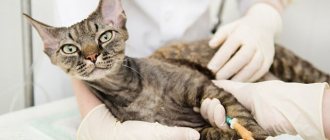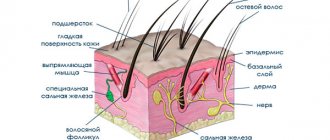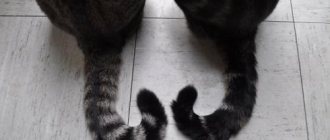Balancing, developing speed, intimidating enemies and even thermoregulation - all these functions in cats are performed by the tail. It contains many nerve endings, which is why the tail is often called an indicator of a pet’s mood.
However, serious damage to it can lead to a fracture. How to recognize an injury in a timely manner? What actions should I take? Specialists from a veterinary clinic in Moscow talk about everything in more detail.
See this article:
Common causes of fractures Signs of a fracture Types of fractures Diagnosis by a veterinarian Treatment: methods and effectiveness
- Gypsum
- Amputation
- Drug therapy
Prevention
Common causes of fractures
A cat's tail is an anatomical extension of the spine, so any damage can lead to serious consequences for the entire body. Most often, the animal is injured at home. For example, if there are small children in the house, then the likelihood of damage increases (dangerous games, tail pulling, etc.).
That is why it is necessary to explain to young children that they are putting the cat in danger by handling it carelessly. Sometimes even simple pranks that seem completely harmless can lead to serious damage to the animal.
Other causes of tail fractures in cats:
- being jammed by a door,
- accidental collision (for example, by a vehicle or bicycle),
- pulling with force,
- falling from a great height,
- attack on the tail,
- other mechanical damage to the lower back or tail itself.
Fracture of the sacrum in a cat
One of the most serious injuries in a cat is a sacral fracture . This condition is extremely dangerous, because... The spinal cord runs through the sacrum (as opposed to the tail).
A sacral fracture is fraught with damage to the nerve trunk and the development of the following symptoms:
- In severe fractures, when the spinal cord is torn by bone fragments, the cat's tail and hind limbs are completely lost. The animal cannot pee and poop “consciously”; the bladder and intestines are emptied at random times. In some cases, the pet dies from rupture of these organs, as normal bowel movements and urination cease completely.
- In milder cases, the tail sag like a whip, the cat drags its hind legs, and involuntary bowel movements and urination are often observed.
Signs of a fracture
The signs of a broken tail are so noticeable that you will spot them right away. The first thing you need to pay attention to is a pronounced visual fracture of the tail. This will be immediately noticeable, so you can quickly respond and seek help from a veterinary clinic in Moscow.
Other signs indicating a tail fracture:
- strong pain,
- increase in body temperature,
- tail inflammation,
- lack of muscle support (the pet’s tail just hangs down),
- paralysis,
- numbness of the tail,
- urinary incontinence,
- the pet's inability to go to the toilet on its own.
These symptoms are characteristic of a tail fracture. However, a serious condition will be accompanied by other (general) symptoms. These include worsening appetite, general malaise and weakness, refusal to play, and lethargy.
When a fracture occurs, the pet drags its tail and cannot control it. This condition is called “dead tail”. It often leads to a decrease or complete loss of sensitivity in the hind legs. All this disrupts the coordination and balance of the animal’s movements.
If you see that your cat's tail is broken, then do not hesitate - contact your veterinarian ! This will quickly relieve pain and avoid possible dangerous consequences.
Symptoms: how to determine if there is a problem?
Externally, you can detect when a cat’s tail hurts due to a fracture. The strength and characteristics of symptoms depend on the type, location and severity of the injury. The general signs are as follows:
- loud meowing, signaling that the cat has broken its tail and it hurts a lot;
- a visually discernible bend in the injured area, while the organ is lowered or bent and does not rise;
- a wound on the cat's tail or an open tear from where the vertebrae are visible;
- increased temperature, swelling and redness of the skin in the tail;
- inability to lift the tail and move it, as it is very swollen;
- blood in urine;
- urinary and fecal incontinence;
- lameness and problems with coordination;
- paralysis, particularly of the hind legs;
- massive bleeding.
Types of fractures
Closed tail fracture . It differs in that the integrity of the soft tissues is preserved. There is no visual damage, but the cat experiences severe pain and loses the ability to control its tail. This type of fracture is usually diagnosed after being pinched by a door or being run over by a car.
Open tail fracture. It is noticeable immediately because the integrity of the skin is compromised and wounds are present. This type is most often diagnosed during a fight with other animals (for example, dogs) and a fall from a great height.
Broken tail. It occurs when the kitten’s skeletal system is not yet fully formed. The vertebrae bend because there is strong traumatic pressure. This form occurs when the tail is pulled back.
Regardless of the type of fracture, you should immediately consult a doctor. Self-medication is unacceptable!
Symptoms and diagnosis
If the owner suspects damage to the tail of his pet, it is necessary to immediately find out how serious the problem is and whether it is really a pearl. Knowing the main symptoms of a tail fracture, the owner will be able to respond adequately :
- The organ at the site of possible injury will be bent. Depending on the severity of the damage, the depth of the bend will depend. If the pearl is indeed present, then a kink in the tail will be evident.
- The tissue around the affected area will be swollen.
- Presence of a bleeding wound.
- Any touch to the injured part will cause severe pain to the animal.
- Increased temperature of the damaged organ and the whole body.
After an injury, the owner should keep an eye on the cat, because a fracture of the tail is not always accompanied by a clear bend. It may appear smooth, but the fact that the injury is serious will be indicated by the pet’s behavior and various signs.
The cat's gait will definitely change: it becomes uneven and staggering. The tail will drag along the ground in an unnatural manner. With a very severe injury, even failure of the hind legs is possible. The cat may behave aggressively because the injury causes him severe pain.
The animal may have involuntary urination, and sometimes there is uncontrolled excretion of feces. But such symptoms do not always indicate that the cat has a broken tail. This is possible if the spine is damaged.
If it is confirmed that the pet has a tail fracture, he needs urgent hospitalization at the veterinary clinic. Doctors will use x-rays to diagnose and prescribe the necessary treatment. In difficult cases, if an animal’s tail injury has led to paralysis, an MRI, ultrasound, and blood test may be prescribed. Also, if the clinic has such a service, electromyography is prescribed. This is a method by which they determine how well nerve impulses travel through the muscles and peripheral nerves, that is, they determine the severity of the injury.
© shutterstock
Cats take various manipulations calmly, but severe pain and the presence of strangers can provoke panic in the animal . It will be difficult to carry out a full diagnosis. In such cases, the veterinarian may decide that general anesthesia is necessary. In this way, he will make his work easier and the condition of the cat, who is experiencing torment.
Diagnosis at the veterinarian
The diagnosis can be made during the initial examination, since a fracture or other serious injury to the tail will be immediately noticeable. The doctor’s main task is to determine which part of the tail was damaged.
To do this you will need:
- visual inspection,
- owner survey,
- radiographic examination,
- blood and urine tests.
All this will allow you to find out how serious the damage is and what treatment the animal will need.
Mechanical injuries
One of the most common groups of pathologies. Most often, something wrong happens to the tails of cats that regularly walk outside. It happens that pets get their tail pinched by a door, in other cases they lose it in fights with other cats or as a result of dog attacks. It happens that cyclists or children run across a tail carelessly laid out on the road... In short, there are a lot of causes of mechanical injuries.
It is easy to notice them: the tail becomes “flaccid”; the cat cannot (and does not want, since it is in great pain) to move it. Please note that not all cases show visual signs of crushing or fracture. At first glance, the organ may appear intact.
The clinical picture is quite specific and easily noticeable:
- When trying to take a cat's tail, its owner reacts extremely nervously and even aggressively.
- The organ can be bent at a completely unimaginable angle to the horizon.
- In the most severe cases, when the injury was really serious, not limited to the tail, urinary/fecal incontinence may occur. This is a very bad sign, indicating either some kind of infection (in advanced cases), or damage to the sacral spine.
Diagnosis and treatment
The specialist will carefully examine your pet's tail and also conduct a series of neurological tests. The latter make it possible to understand whether the animal’s nervous system is damaged. In particular, if the cat has no tail sensation at all, treatment options will be limited.
The following types of diagnostic tests are recommended:
- Complete blood test, including checking its biochemical status.
- Analysis of urine.
- It is necessary to perform radiographs of the sacral and caudal spine. Often, after taking a photo, it becomes clear what exactly happened to the pet.
Treatment, as we said above, depends on the underlying cause identified by a veterinarian.
- In cases where the injury is not serious (mild bruise), simple rest will help.
- In more severe cases, it is often necessary to resort to amputation of the affected part of the body.
Note that when the tail is dislocated, it is often possible to confine itself to its reduction: other medical care (as a rule) is no longer required after this. Even with wounds, it rarely comes to surgery. If, of course, the owners at least somehow provided assistance to their pet.
Treatment: methods and effectiveness
The treatment for an injury depends on the extent of the damage and the location of the wound. If the fracture is diagnosed closer to the tip of the tail, then no major surgical intervention will be required.
If an open fracture is diagnosed, treatment will take longer. It involves removing bone fragments and severe bleeding. It requires immediate stopping, as it poses a threat to the health and life of the pet.
To remove fragments and examine the destroyed vertebrae, drugs for local anesthesia are used. This will ensure the safety of the animal and prevent possible discomfort during the intervention.
To prevent infection from entering the body through damage, the doctor will prescribe a course of antibacterial therapy.
Gypsum
Typically, for fractures and severe dislocations of the caudal vertebrae, plaster is prescribed. An alternative to plaster is applying a fixing bandage. Plaster is not very convenient for a pet, so it is used in rare cases. Most often, veterinary clinics use fixing bandages applied directly to the pet’s tail.
After applying a cast or bandage, you will need to use a special collar. On average, the duration of such treatment is about 21 days. In especially severe cases, the period of wearing the fixing bandage is increased. A mandatory requirement is to monitor healing using x-rays.
Amputation
This is a radical treatment method, used quite rarely. It is used only for special indications, which include tail paralysis or an open fracture at the very base of the tail. The surgery is performed under full anesthesia, so your pet will not feel pain or discomfort.
After amputation, quite a long rehabilitation will be required, taking from 14 to 20 days. Possible consequences of injury include the inability to go to the toilet on your own. In this case, the owner will need to manually massage the bladder and help the pet empty its bowels.
Drug therapy
It is not used as an independent treatment, but is prescribed separately (in addition to plaster or amputation). Drug therapy involves taking a number of medications necessary to restore the pet’s body and strengthen it. If necessary, vitamin and mineral complexes are prescribed.
Remember that only a doctor can prescribe effective treatment. Do not risk the health of your beloved pet - entrust its treatment to specialists.
Tail anatomy
In order to understand how dangerous a tail fracture can be for a cat, you need to find out what this organ is, how it works, and its importance for the animal.
© shutterstock
The cat's tail is an extension of the spine and is attached to the sacrum. It is divided into three parts :
- root - beginning;
- stem – the tail itself;
- the tip completes it.
It consists of numerous vertebrae, their number varies from 19 to 39. The cavities between the vertebrae are filled with a jelly-like substance, which ensures their lubrication and mobility. There are many blood vessels and nerve endings running along its entire length. The muscles of the tail are connected to the muscles of other organs. Therefore, if it is severely injured, displacement of the spine may occur. All this will entail a malfunction in the functioning of other organs: the kidneys, bladder, problems with defecation appear, and nerve innervation is disrupted.
The tail vertebrae are important for the animal to coordinate its movements and orientation in space. You can determine the mood and health status of your beloved pet by looking at the fluffy cat decoration.
Prevention
The most important thing is to handle animals carefully. There is no need to pull or catch the cat's tail, especially if it is trying to escape. Do not leave windows open if there is a pet in the house. The best solution is to install a net in advance to prevent falls from great heights.
These simple rules will help you avoid such unpleasant and dangerous situations as a broken tail. However, in any case, do not forget that help will need to be provided to your pet immediately!
What to do if you suspect an injury?
Don't panic and don't touch the tail under any circumstances! You can dislodge the vertebrae, cause bleeding and increase pain. The best thing to do is to take your cat to the vet in a carrier.
If you do not have the opportunity to immediately show your pet to the doctor, create comfortable conditions for her in which she can wait for the examination. Make sure that the cat is not touched by other animals or people. Eliminate any noise if possible. Place water next to the bed, pat your pet on the head, and offer her a treat. If the tail is bleeding, treat it with chlorhexidine to prevent infection. Call the clinic and consult with a specialist, listing all the symptoms. Perhaps he will advise what pain reliever can be offered to your pet.
Next, observe the cat’s behavior and the condition of the tail: does it swell, lose mobility, etc.
First aid for tail injuries
First, you need to carefully trim the hair around the wound canal, cleaning its surface as much as possible. It is advisable to cover the wound with a sterile gauze pad so that the falling hair does not end up anywhere other than it. When you are done with hairdressing, just as carefully remove hairs, blood and adhering dirt from the edges of the wound (the same saline solution or warm boiled water). In any case, you need to work so that nothing foreign gets inside the wound canal - no fur, no water, no dirt. Washing damage (except for very light scratches) is strictly prohibited!
After this, some ointment can be applied to the edges of the wound (to facilitate subsequent removal of the bandage). It is best (and you probably have them in home medicine cabinets) to use tetracycline or ichthyol . Again, there is no need to push them “deeply”! Fatty creams and ointments prevent air access, and this is dangerous due to the possible development of anaerobic microflora. The surface of the wound, if possible, can be treated with streptocide powder . And only after this, having additionally covered the injury with a thin cotton-gauze napkin, apply a bandage.
By the way, the last one is the most difficult. It is necessary to bandage the wound so as not to impede the access of air and not to crush the large tail vessels. But at the same time, you need to try to do this so that the cat does not get rid of the bandage within a couple of minutes. What to do next?
In the next 24 hours, look at the bandage: if it is moderately saturated with blood, which gradually dries out, everything is in order. If all is well, then change the bandage once a day according to the method described above. In cases where all signs of severe inflammation are visible, pus and/or an unpleasant odor appear, you should immediately contact a veterinarian! Further “amateur activities” will not lead to anything good.
Genetic pathologies
Are there other causes of curvature of the tail in cats? Yes, and there are quite a lot of them. In particular, in the Burmese breed, a crooked tail is an extremely common pathology that is inherited. Sometimes a litter can contain more than 50% of these kittens. Of course, animals with such a defect are strongly recommended to be excluded from the reproduction process, but in reality this is not always possible. Owners of “crippled” pets can take comfort in the fact that the pathology does not in any way affect the health and quality of life of the cat.
It is much worse and more dangerous when the curvature of the tail is caused by some kind of neurological disorder. For example, pathology can develop after severe head injuries or diseases accompanied by damage to the nervous system. Finally, the tail can take on “extravagant” shapes after pinching, injuries to the back and specifically the spine. The fact is that with these pathologies there is a very high risk of pinched nerve bundles and damage to the spinal cord.
Important! So if the curvature of the tail is accompanied by a shaky and uncertain gait of the pet, you often notice that he has poor orientation in space, you must definitely contact a veterinarian.
Source
Why don't people like cats in Vietnam?
What is this connected with? There are several opinions.
The sonorous and drawling manner of speech of the Vietnamese, in itself, resembles meowing, and the cat’s “meow” is consonant with the Vietnamese word for “poverty”, so superstitious people, not wanting to listen to constant reminders of the deplorable state of affairs, found a way out - simply cats at home don't start. Therefore, this is not so much a manifestation of personal sympathy as submission to superstition. On the one hand, they can be understood - it’s easy to give up under such parting words. There is another version: the Vietnamese believe that cats imitate a child’s cry with their meows and can lure a person to a dangerous place. But this option sounds far-fetched and unlikely.
In its peculiarity, Vietnam is reminiscent of Egypt: although cats are revered there, the Vietnamese also show a kind of exceptional attention, endowing animals with powers that they do not have.











